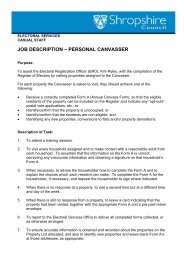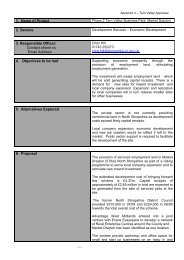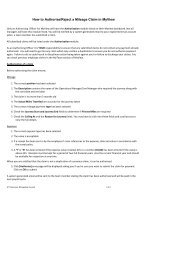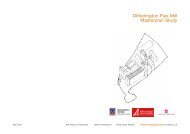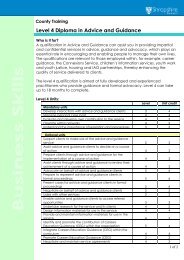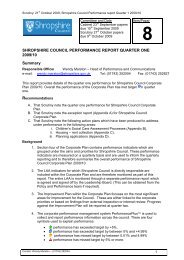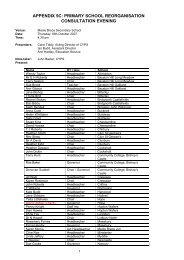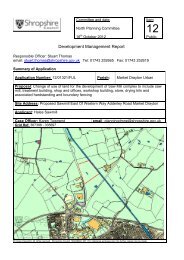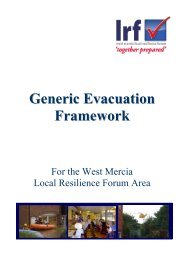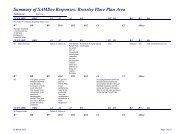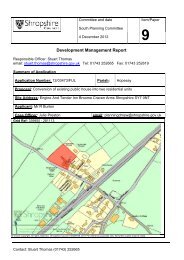23 roman catholics.pdf
23 roman catholics.pdf
23 roman catholics.pdf
You also want an ePaper? Increase the reach of your titles
YUMPU automatically turns print PDFs into web optimized ePapers that Google loves.
History<br />
<strong>23</strong>. A short guide to<br />
Roman Catholic records<br />
England and Wales were Catholic countries until the Reformation and the separation<br />
of the Church of England from the Catholic Church (complete in 1559).<br />
From 1559 to 1778, it was illegal to attend Catholic services. Catholic priests faced<br />
jail or even execution. Until the late 18 th century, Catholics were excluded from<br />
official posts and faced extra taxation.<br />
Despite this, some people continued to hold to the Catholic faith. They were known<br />
as ‘recusants’ or ‘papists’.<br />
In Shropshire, only a small number of Catholics remained active after the<br />
Reformation. They were served by priests from abroad, who were usually<br />
attached to the houses of the leading recusant families.<br />
Most of the anti-Catholic laws were repealed by 1829 (when the Catholic<br />
Emancipation Act was passed).<br />
Shropshire’s Catholic population increased hugely with the industrial expansion of<br />
Telford and Shrewsbury and influx of Irish settlers.<br />
Madeley was the earliest public Catholic church to be built in the county in 1853,<br />
followed by the Catholic cathedral in 1856.<br />
In 1851, the Roman Catholic diocese of Shrewsbury was formed. It included the<br />
counties of Cheshire, Shropshire and the 6 northern counties of Wales (detached<br />
in 1895). Shrewsbury was the centre until it moved to Birkenhead in c 1985.<br />
Catholic Records<br />
Shropshire Archives holds records for many Catholic churches in Shropshire.<br />
The registers are an excellent useful source for genealogy. For example, the<br />
baptism registers often give the mother’s maiden name. Also, details of an<br />
individual’s confirmation or marriage were sometimes added to the baptism entry.<br />
The earliest registers, made illegally by priests, date from 1763. They are rough<br />
notebooks written in English.<br />
The later ready-printed registers are in Latin, up to the present day. They are:<br />
liber baptizatorum (baptism register)<br />
liber confirmatorum (confirmation register)<br />
liber coniugatorum or liber matrimoniorum (marriage register)<br />
liber defunctorum (burial register)
Useful words: natus/nata (born), baptizatus/baptizata est (baptised), filius (son), filia<br />
(daughter), patris (father), matris (mother), de quo loco (of what abode), uxor eius<br />
(his wife), olim (once i.e. neé), in matrimonio conjunxi (married), sepultus/sepulta<br />
(buried), mortuus/mortua (dead), ), sponsorum (godparents), n.b. sometimes<br />
patrinus et matrina are also used for godfather and godmother.<br />
NB Latin verbs vary according to gender and case. Names are often Latinized (eg<br />
Johannes for John). Eileen Gooder’s Latin for local history (447.82) is helpful.<br />
All of the registers are available on microfiche. The microfiche must be used to<br />
protect the originals, which are often very fragile. Catholic registers are closed for<br />
100 years.<br />
There are some transcripts of the registers – see the list of non-conformist registers<br />
(the blue section at the back of the parish registers list).<br />
Other Records<br />
Remember that between 1754 and 1837, all marriages (except for Quakers and<br />
Jews) had to take place in the Church of England to be legal.<br />
Under the Act of 1606, baptisms were supposed to take place at the parish church<br />
within one month of birth (under a £100 penalty). Sometimes diocesan court<br />
records contain references to offenders - these are held at the relevant diocesan<br />
record office. Occasionally ‘papist’ is noted by a baptism in a parish register.<br />
Some of the earliest references to Catholics are found in official records:<br />
An Act of 1657 required people to ‘abjure’ (deny) the papacy. Those who refused<br />
to do so were presented at the court of Quarter Sessions and so may appear in<br />
the order books or rolls.<br />
From 1673 holders of civil and military office had to prove that they had attended<br />
Anglican services and received Holy Communion. They had to obtain a<br />
‘sacrament certificate’ which was deposited with Quarter Sessions.<br />
Under Acts of Parliament of 1715 and 1717, Catholics were required to register<br />
their names and estates with the Clerk of the Peace. The records made under<br />
these acts cover the period 1717-1790 and are in the Quarter Sessions.<br />
Some references to Catholics can be found in sources at The National Archives.<br />
There are some indexes and transcripts for Shropshire entries – search our<br />
library catalogue for more details.<br />
Useful books and addresses<br />
Catholic parishes: an atlas (p929.3)<br />
D J Steel, Sources for Roman Catholic and Jewish Genealogy (939.432)<br />
Tracing Catholic Ancestors (PRO pocket guide) – for sale in Reception<br />
Catholic Family History Society, 45 Gates Green Road, West Wickham, BR4 9DE.<br />
Catholic Record Society, 12 Melborne Place, Wolsingham, Durham, DL13 3EH.<br />
Short guide to sources no. <strong>23</strong> (11/09)<br />
Shropshire Archives<br />
Castle Gates, Shrewsbury SY1 2AQ<br />
tel: 01743 255350, fax: 01743 255355<br />
e-mail: archives@shropshire.gov.uk<br />
web site: www.shropshirearchives.org.uk<br />
W/Archives and Archaeology/Archives/Information Services/Onsite/Publications/Subject Handouts new



